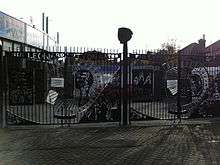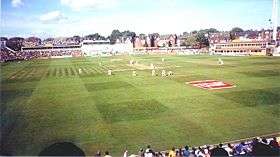Headingley Cricket Ground
 | |||
| Ground information | |||
|---|---|---|---|
| Location | Headingley, Leeds | ||
| Coordinates | 53°49′3.58″N 1°34′55.12″W / 53.8176611°N 1.5819778°W | ||
| Establishment | 1890 | ||
| Capacity | 17,500 | ||
| Owner | Yorkshire County Cricket Club | ||
| End names | |||
|
Kirkstall Lane End Football Stand End | |||
| International information | |||
| First Test |
29 June – 1 July 1899: | ||
| Last Test |
19–23 May 2016: | ||
| First ODI |
5 September 1973: | ||
| Last ODI |
1 September 2016: | ||
| Team information | |||
| |||
|
As of 1 September 2016 Source: ESPNcricinfo | |||
Headingley Carnegie Cricket Stadium (usually shortened to Headingley) is a cricket ground in Headingley Stadium complex adjoins the Headingley Carnegie Rugby Stadium through a shared main stand, although the main entrance to the cricket ground is at the opposite Kirkstall Lane end. It has seen Test cricket since 1899 and has a capacity of 17,500.
Notable sporting moments

In 1902, Yorkshire beat the touring Australians by five wickets, after dismissing them for 23 in their second innings with George Herbert Hirst and Stanley Jackson taking five wickets each.
Donald Bradman's innings of 334 in the 1930 Ashes Test included 309 runs on the first day, and he followed it in the Australians' next test at Headingley in 1934 with an innings of 304.
Spinner Hedley Verity took 10 wickets for 10 runs in 1932 for Yorkshire v Nottinghamshire, still the best bowling analysis ever in first-class cricket. Verity had also taken all ten against Warwickshire at Headingley in 1931.
In the 1948 Ashes series, Australia scored 404 for three on the last day to beat England. Arthur Morris scored 182 and Bradman scored 173 not out.
In the Third Test against New Zealand in 1965 John Edrich hit 53 fours and 5 sixes in his 310 not out. Captain M. J. K. Smith declaring before Edrich had a chance to pass Gary Sobers' Test record 365 not out, and England won by an innings and 187 runs.[1]
In the third test match of the 1975 Ashes series (a four-test series), early on Tuesday 19 August head groundsman George Cawthray discovered that campaigners calling for the release from prison of George Davis had dug holes in the pitch and poured oil over one end of the wicket, This led to the match being abandoned and declared a draw, denying England the chance to win back the Ashes.[2]
In the 1977 Ashes test, Geoff Boycott scored his hundredth first-class hundred. Four days later, by winning the same game, England won the series and regained the Ashes.
However Ian Botham scored 149 not out, and then Bob Willis took eight wickets for 43, to give England an eventual 18-run victory. Two members of the Australian team had taken the 500–1 odds. This was only the second time in the entire history of Test cricket that a side had followed-on and won; something which would not occur again until 2001.[3]

In the Test of 1991, Graham Gooch scored a match-winning 154 not out, carrying his bat throughout England's second innings of 252, against the West Indies including Malcolm Marshall, Curtly Ambrose and Courtney Walsh.
In a game they had to win to stay in the 1999 Cricket World Cup, the eventual cup-winners Australia chased down South Africa's 271 for seven after being 48 for three. Steve Waugh, who had been dropped by Herschelle Gibbs as he attempted to throw the ball up in celebration, scored 120 not out.[4]
In 2000, England dismissed the West Indies for 61 to win by an innings and in two days, with Andrew Caddick taking four wickets in an over. England won again seven years later in 2007, as Ryan Sidebottom took eight wickets for 86 in two innings as England subjected the Windies to their worst Test defeat ever, an innings and 283 runs.
In August 2001, England successfully chased 315 to beat Australia, with Mark Butcher scoring an unbeaten 173 as England won by six wickets.[5] However in August 2009 in the 4th test of The Ashes series, Australia beat England in 2½ days by an innings and 80 runs. Australia took twenty wickets with an attack without a spin bowler. England's middle order batsmen (Ravi Bopara, Ian Bell and Paul Collingwood) scored 16 runs between them in two innings.
Other events
Headingley Cricket Ground's first concert occurred on Friday 18 September 2015 when Ska band Madness performed in front of an audience of 7,500.[6][7]
See also
References
| Wikimedia Commons has media related to Headingley Stadium (cricket ground). |
- ↑ "The Home of CricketArchive". Cricketarchive.com. 13 July 1965. Retrieved 7 April 2013.
- ↑ "1975: Davis campaigners stop Test match". BBC. 31 December 2009. Retrieved 1 January 2010.
- ↑ "In Depth | The Ashes". BBC Sport. Retrieved 7 April 2013.
- ↑ "9th Super Six Match: Australia v South Africa at Leeds". 13 June 1999. Retrieved 18 September 2016.
- ↑ "4th Test: England v Australia at Leeds". 16–20 August 2001. Retrieved 18 September 2016.
- ↑ "British pop icons Madness to perform at Headingley". Retrieved 18 September 2016.
- ↑ "Madness prove to be a big hit - at Headingley". Yorkshire Evening Post. 19 September 2015. Retrieved 18 September 2016.
Coordinates: 53°49′01″N 1°34′56″W / 53.81694°N 1.58222°W
